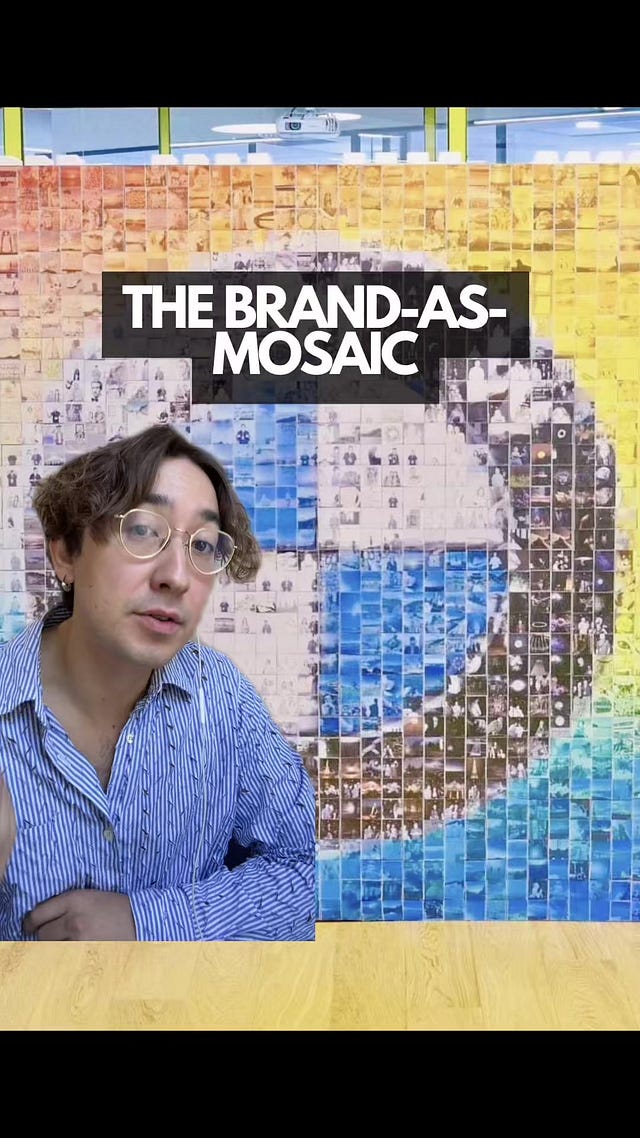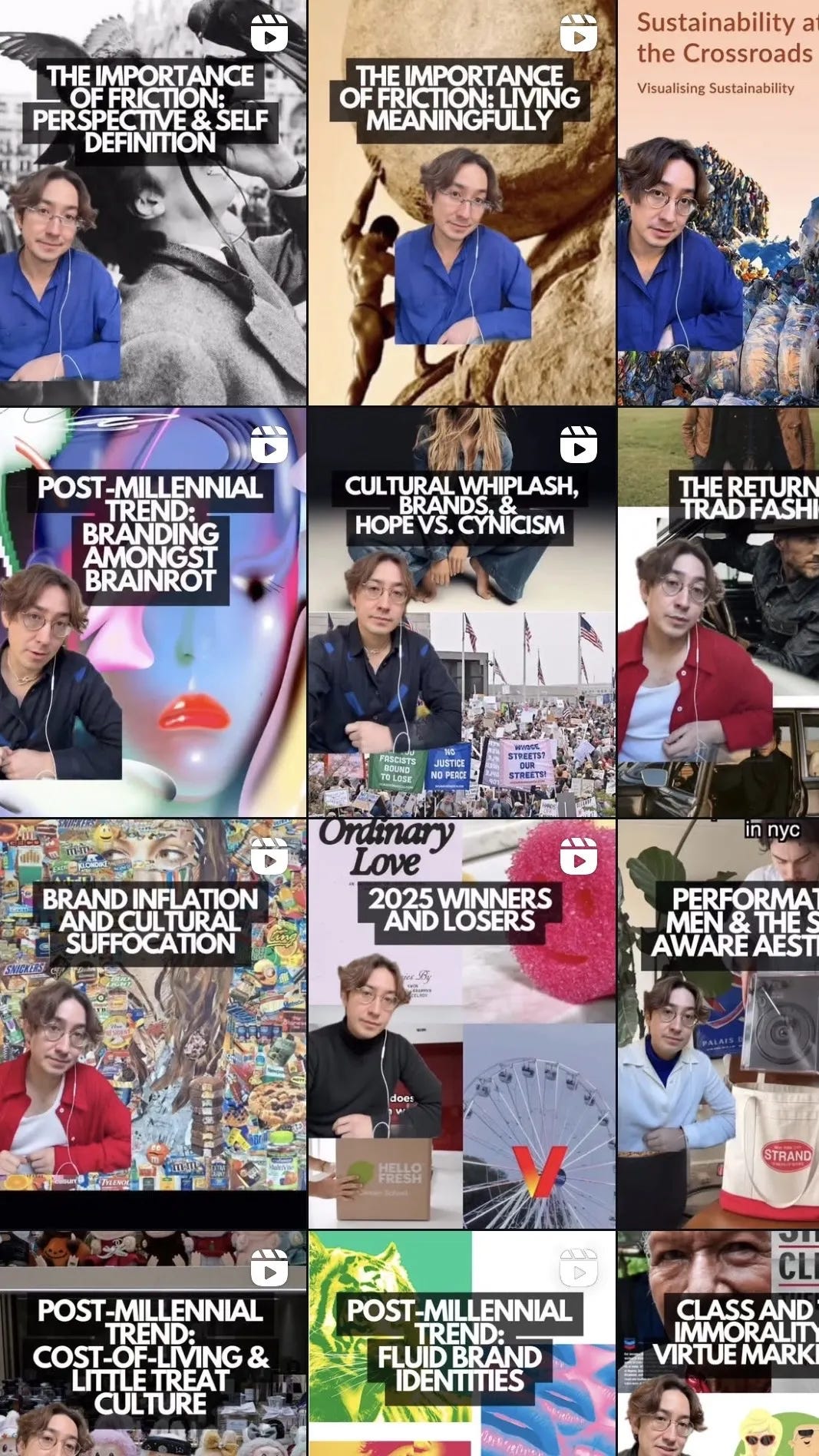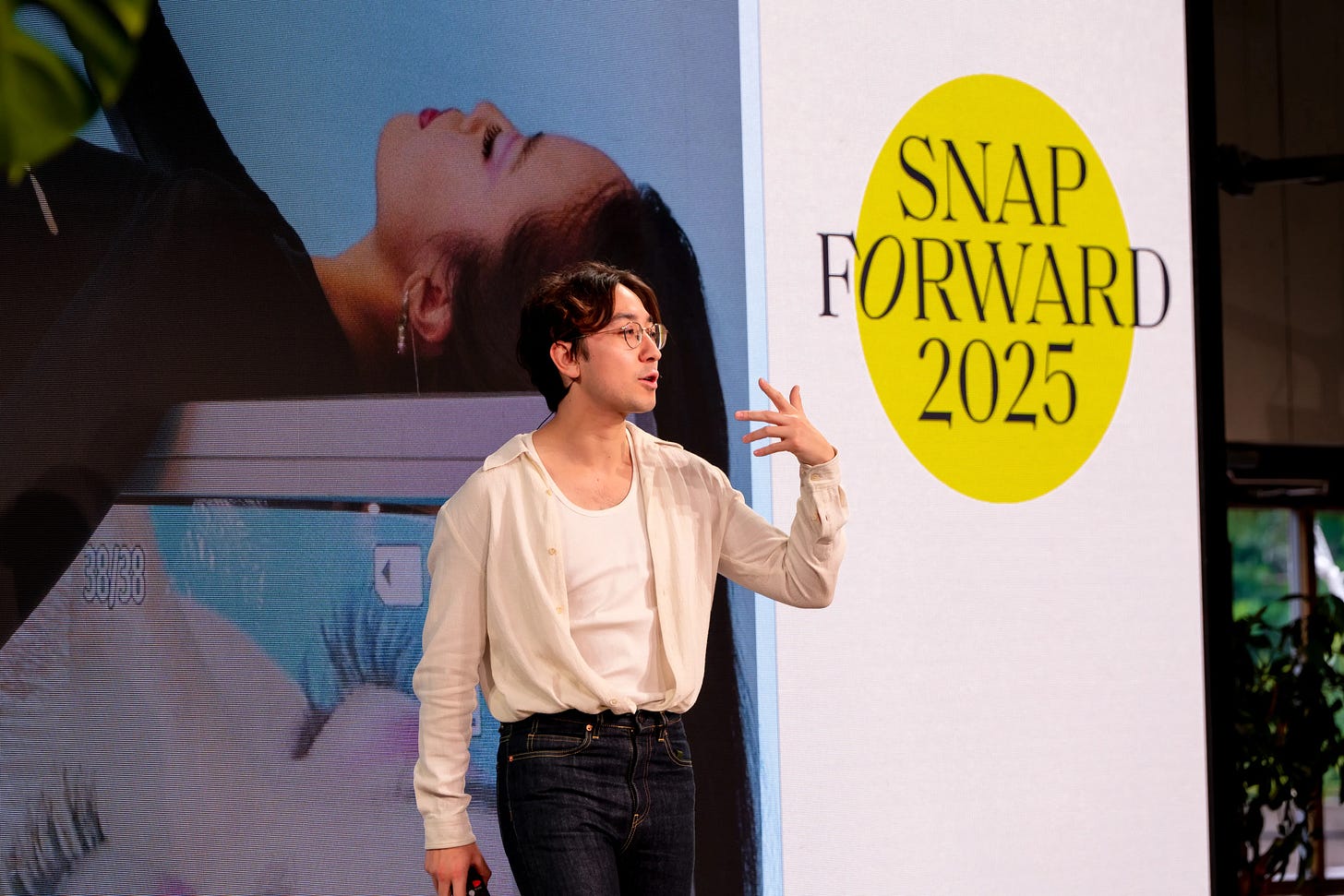How (personal) brands are built in the modern algorithmic era
Lessons on the journey to 400,000 followers
A couple notes:
I am delivering a guest lecture: ‘The Strategist-as-Brand: Cultivating Personal Trust amongst Institutional Collapse’ for Nemesis Global’s Autonomous Strategy III workshop, beginning November 2 (I am speaking on the 30th). Early bird tickets are now on sale - sign up here.
Also, I am currently full up for strategy projects until at least mid December - apologies if I haven’t gotten to your emails!
In early September I realised I’d crossed another cute milestone: I’d hit 400,000 followers across platforms (Instagram, TikTok, LinkedIn, Substack).
I’ve had some time to reflect on my journey and distilled it into a couple actionable lessons for you - if you’re a marketer, a creator, or anyone that’s looking to build a personal brand, or indeed, a brand in the modern algorithmic era.
This isn’t gospel. Take what you need, leave what you don’t, hope it helps you. This stuff is incredibly difficult and the least we can do is support one another if you’re going to put yourself out there.
Create Around A Cultural Idea Bigger Than What You Sell
If you look all the way back to the beginning of my platforms, you’ll see very classical ‘strategist’ content: what is an insight, what is ‘good’ strategy, rating the rebrand etc.
It’s not just that this content is fucking boring, it’s that it has a very narrow aperture. I was creating entirely within the boundaries of what I was trying to sell - brand strategy projects. To be frank, there was not a hell of a lot to say on this, certainly not enough to sustain a consistent, novel posting calendar.
The unlock came when I landed on a much bigger topic: society revealed through the lens of brand.
This allowed me to really hone in on how I wanted to position (as an educator), and what I wanted people to get out of my channels - to learn about the world, how things are, and why they feel the way they do.
It’s from there I scaffold those cultural insights into brand imperatives.
A HUGE portion of people who follow me don’t live within my ‘customer’ profile i.e. senior marketers who hold strategy budgets, brand owners, or conference organisers; in fact many of them live outside the marketing world altogether.
But the reality of the modern algorithm is that to get to the 50,000 people you really want to talk to, you need to speak to 1,000,000. I tend to agree with Byron Sharp on this one - go as big as possible.
Find a topic you can own, that speaks directly to your expertise but universalises it. Or just own a fun cultural idea full stop that you can become known for - like lalaland kind cafe that racks up millions of views ‘spreading kindness’ on TikTok.
Tracksuit, one of the key partners I work with, has taken a cultural position akin to the ‘fearless advocate for brand’ - that gives them scope to engage in a wide range of conversations around how marketing budgets are allocated, how teams are organised, even how brands are built. We’ve done multiple keynotes together on these topics. From here, we then sell in the (much narrower) product - brand tracking software.
You can then dispense this accumulated attention and brand equity as you see fit, which leads me onto my next point…
Your Content Is A Funnel
As I’ve gotten more experienced I’ve been able to create forms of content that correlate into 3 parts of the marketing funnel.
It may seem like basic advice but you should be thinking about what you make in terms of what you want it to accomplish - and those things are often distinct enough to warrant distinct approaches.
Awareness
This content is designed to have as mass appeal as possible and will always tell a story about where culture is at right now. Often it may not even scaffold into a brand imperative, as seen with my recent ‘Soft Clubbing’ piece—now sitting at 2 million+ views across platforms.
It’s pure ‘brand building’: demonstrating the way that I think and see the world (irregardless of my career in education/brand strategy), it brings new people into the tent - and crucially for me, it helps me to fulfil a goal of reaching and educating people who live outside the discipline of marketing.
This content is also designed in part to keep my account tagged as a high-performing one, which helps with algorithmic distribution for more niche pieces of content.
Consideration
This content is closest to classical ‘thought leadership’. I’ll deconstruct a particular cultural phenomenon happening in culture before tying it into how brands need to show up differently.
Like all ‘thought leadership’ this is based around getting people who already live in the audience to lean in further and think deeper. It often ends up being the kind of piece that’s shared most actively on a platform like LinkedIn - between my actual peers.
The goal here is to build mental associations around authority that are activated later: most commonly conference organisers will cite this type of content when they reach out.
Acquisition
This is specialised content that will speak about brand/marketing strategy with little or no cultural angles in it.
I’ll dig into deeper thinking about org structure, incentives, comms models etc.
And it will generally end with an actual CTA: get in touch to book a keynote or strategy project.
Less than 10% of the content I make will be acquisition oriented. The content always performs very poorly, but ignites a lot of actual conversations. My Brand-As-Mosaic video (one of my core theories) has led to at least half a dozen actual bookings.

 Tiktok failed to load.
Tiktok failed to load.Enable 3rd party cookies or use another browser
Content-As-Practice
Social media is a flat playground in which past and future are obliterated - the only thing that seems to matter to the audience is what you’re saying in the moment. Legitimacy is important but it’s built after-the-fact.
We live in a dupe culture where it’s not only products, but ideas that are replicated.
I regularly have people steal my video ideas, turn my scripts entirely into foreign language and repost as if it’s their own, or just set up fake accounts and repost pieces of content.
To be frank, this is unavoidable - but if you’re good, it doesn’t matter at all. You’ve already moved on.
I make money off my perspective. The better the perspective, the more I make. And content is a way of developing my perspective. It is a practice as much as it is an outcome.
Each week as I script, I’m constantly thinking of how to refine my existing perspectives, reading shitloads of other thinkpieces or entertainment or literature and from that, constantly synthesising something new. This feeds the flywheel of my entire business: new content might one day become a keynote, which can be fragmented into additional pieces of content, which might be an idea that hooks someone in for a strategy project, etc.
This is the only way to beat the dupes - to always stay two steps ahead of them.
If you only think of content in terms of deliverables, something that ‘has’ to be pumped out weekly to satisfy the algorithm, you will burn out quickly (and your well of ideas will dry up quickly, too). Then your content will be duped.
But if you can consider it as a ritual that you undergo, intellectual weightlifting that strengthens the muscle of your perspective, you are effectively cumulatively building up the right to command higher margins over time.
Persona Over Authenticity
In my opinion the worst advice you can give someone starting out is to ‘be authentic or be yourself’.
Beyond the fact that it’s really vague, social media is a Colosseum—it is performative by design.
As I wrote in The Guardian a few months ago, what we call ‘authenticity’ is itself an aesthetic that is performed for the camera.
It’s better to think of yourself as a character and ask what persona you want to imbue that character with. I had a head start on this—the character you watch in my videos is effectively my lecturer persona—an educator who wants to help people understand society through the lens of brand.
I even built a brand platform off the back of this. There’s a lot of the “real” Eugene Healey in this, but importantly, there’s distance between me and this entity. This is important because it shows you don’t need to be an ‘influencer.’ I’ve managed to build a following of this size while keeping my personal life personal.
Distinctive Brand Assets
Algorithms reward novelty within boundaries. You need to be novel enough to stand out from the pack, but too novel and you’ll be impossible for your audience to recognise. This is where distinctive brand assets come into play.
For those of you who don’t work in brand, a ‘distinctive brand asset’ is any unique and recognisable cue that instantly triggers memory and association with a specific brand. In the context of social, it is about consistently deploying recurring visual motifs, signature editing styles, catchphrases, or a consistent tone of voice.
For me, it’s my face green-screened onto an image, the titles I use for my videos, and yes, even my stupid, wired Mac headphones.
I just had one of my worst-performing videos ever. In the post-mortem, I realised it’s because you couldn’t clearly see any of my distinctive brand assets within the first 3 seconds. The power of a brand asset is cumulative; you are rewarded exponentially as you build familiarity with the audience over time.
Remember that people’s heads are basically an overstuffed sock drawer, and if you can get a couple of their brain cells to recall who you are, that is more than half the battle.
Synthetic Vs. Real Influence
I think it’s important to recognise that the influence you build on social platforms is ‘synthetic’.
There is an algorithmic debuff. It doesn’t matter if you’re getting millions of views, people will always look at you as two-dimensional if all you do is post to TikTok and Instagram. You should prioritise how to add other dimensions as soon as possible.
I do a lot of in-person keynote speaking; it’s one of my core revenue streams. I also saw significant growth when I wrote a couple of articles for The Guardian. These legacy publications are always concerned with how to bring in new audiences. If you have a complementary voice, there’s an equal exchange here: they grant you legitimacy, you grant them relevance.
This post crystallises much of my thinking from a keynote delivered in Marrakech in September - a society where people are increasingly turning themselves into brands, myself included.
To step out in front of all of you each week, to be recognised in public, to travel to 5+ countries to speak, has been a strange, dissociative process that’s nonetheless been the most rewarding point of my career so far.
I hope that through my work I’ve helped to make learning fun again. Thank you for tuning in.
Eugene



